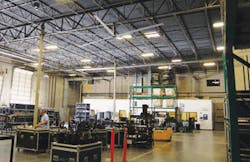Looking at safety statistics, it's easy to conclude that the loading dock is one of the most hazardous areas of your operations. A quarter of all accidents occur there. The majority of these accidents result in the dreaded back injury that, according to OHSA, ultimately ends up costing U.S. companies upwards of $80 billion dollars annually.
With staggering numbers like these, not even the largest and safest companies doubt that the loading dock is potentially dangerous. However, by taking steps to address these top areas of concern, it can be safer.
Loading Dock Drop Offs
With a height above the driveway of more than four feet, open and unprotected dock doorways can be an accident waiting to happen. Equipment and signage that warns employees of danger ahead can help them avoid driving off the dock in a forklift or stepping too far and falling. In the past, chains or thin weak metal were used to "prevent" falls—hardly an effective means of stopping five tons of fork lift.
Of course the best way to prevent driving or falling off the dock is to keep the door closed. However, in situations where the door needs to be open (for ventilation in warmer climates, for example), there are a couple options that are effective safety measures.
Hydraulic dock levelers equipped with a barrier lip can help prevent accidental roll-off. When the dock leveler is in a stored position, the lip extends above the floor by 5 inches. This solid steel barrier stops forklifts or other traffic and avoids the all too common "drop offs." The lip acts as a smooth bridge for forklift traffic, withstanding impact from a 10,000 lb. forklift traveling at four miles per hour.
A steel or fiberglass impact barrier acts as a lower impact barrier bar, and is generally constructed of 9/16"-thick steel cable inside a flexible fiberglass rail. It is capable of stopping a 10,000 pound fork lift moving at four miles per hour. These highly visible barriers can also prevent pedestrian traffic from getting too close to the edge of the dock.
Also, wall openings such as dock doorways should be protected as advised in the OSHA regulation 1910.23(b). Remember, a chain doesn't cut it.
Slips, Trips and Falls
One of the most frustrating things about slips, trips and falls is that they're easy to prevent. In 2008 and 2009, 10,000 employees suffered an injury as a result of slipping, tripping or falling in one way or another. One way to increase their probability is to allow floors to get slick or wet. Add forklift traffic and moving product, and you have a recipe for disaster.
Keeping floors dry must be a top priority at the loading dock. Product solutions can support safety policies.
Dock seals and shelters—fabric structures mounted on the exterior of the building around the top and sides of the loading dock door opening—are designed to seal out the elements and prevent energy loss. Snow, sleet, rain and condensation build up can be hard to prevent, but seals and shelters can provide an effective barrier against them.
A rain sealing system can also be mounted over a dock seal or shelter to wipe the water off the top of the trailer with a "wiper" pad as the vehicle backs into position.
High volume low speed (HVLS) fans can not only help remove moisture by promoting air movement, but they can also keep employees comfortable in large spaces. The light-weight blades of these large fans produce a massive column of air that flows down toward the floor and outward in all directions before drawing it back vertically toward the blades, creating what is known as the horizontal floor jet. The floor jet produces improved circulation but also helps minimize floor condensation, keeping areas drier and safer.
Trailer Creep
A trailer should only move when you want it to. It should never creep. That's why the Occupational Safety & Health Administration (OSHA) requires the use of preventative measures such as restraints while loading and offloading trailers. Powered vehicle restraints equipped with LED communication lights can keep the trailer as tight against the building as possible while communicating the status of the trailer to dock attendants and drivers.
OSHA regulation 29CFR 910.178(k)(1) stipulates that all trucks must be restrained throughout loading and unloading operations. The safest solution is to make the trailer an extension of the facility by effectively anchoring or restraining the trailer in place with a mechanical or powered vehicle restraining system that engages the rear impact guard or the rear wheels of the trailer.
LED communication light systems provide visual confirmation of dock status for dock workers and truck drivers using green/amber/red flashing lights on the interior control panel and on the exterior building wall. These communication lights can help prevent trucks from pulling away from the loading dock prematurely and causing a forklift to drive off the dock.
Placing a priority on implementing safety measures on the loading dock is important, not only because of the frequency of dock accidents, but also because of their severity.
Michael Brittingham is marketing communication manager at Serco Entrematic (www.sercocompany.com).




